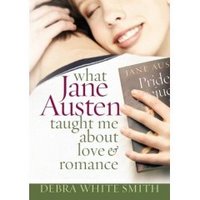Please welcome Debra White Smith, our guest blogger. With her new book releasing in January 2007, Debra talks about what she's learned from Jane Austen and sharing it with Novel Journey. Debra White Smith has more than 40 books to her credit and over 1 million books in print. The author of Romancing Your Husband (more than 100,000 copies sold) and the popular Jane Austen series, Debra’s award-winning writing, entertaining humor, and solid biblical knowledge have made her a reader favorite and a sought-after conference speaker. Debra holds an M.A. in English.
Debra White Smith has more than 40 books to her credit and over 1 million books in print. The author of Romancing Your Husband (more than 100,000 copies sold) and the popular Jane Austen series, Debra’s award-winning writing, entertaining humor, and solid biblical knowledge have made her a reader favorite and a sought-after conference speaker. Debra holds an M.A. in English.
My next book releasing is January 2007 is What Jane Austen Taught Me about Love and Romance. A nonfiction wrap-up to the Jane Austen Fiction Series, this book takes the Great Love Chapter, 1 Corinthians 13, and highlights the way Jane Austen reveals the differing facets of love in her novels. Here's the back cover copy: Dear Jane…
Dear Jane…
I always ache for Knightley's unrequited love for Emma...celebrate the sparkling excitement between Darcy and Elizabeth...long for Edmund to wake up to Fanny Price's undying love...and cheer for Elinor Dashwood as she learns to love Edward with abandonment. I sigh when Anne Elliot and Captain Wentworth are finally reunited...and laugh out loud at the forever naive and dear Catherine Morland as she bungles her way into Henry Tilney's heart.
What a cast of characters. What a writer. What a woman you were! The novels you wrote have forever left an impression upon my mind, my heart, and my writing.
Your devoted fan,
Debra White Smith
In tribute to Jane Austen’s genius at revealing the intricacies and foibles of affairs of the heart, bestselling romance writer Debra White Smith highlights the delightful interactions between Austen’s people and celebrates the many facets of love. Drawing on her own irrepressible humor, Debra also shares her often hilarious encounters in her quest for love to reveal the timelessness of romance.
An insightful and charming read for anyone who loves Jane Austen, romance, and laughter.
Please share with us something you've learned about writing in your journey as a novelist.
I never seem to get to a point in writing novels where I stop learning. I'm forever turning a corner and bumping into new insight or a new way of crafting my stories. In the last few years, there have been several "Eureka!" moments I've experienced, but I think the strategic use of details and description has been a long lesson and one that I'm still trying to perfect.
BALANCE IN DETAILS
Scene: I'm a detail person and love to include realistic, concrete details in my novels. However, I've learned that you can actually use key words and phrases to bring up an immediate image in your reader's mind that save you the necessity of going into too much description. For instance, "antique dresser." Most readers already have an "antique dresser" image "saved" in their mental files.
So, unless there's a specific reason to go into detail on the intricacies of that dresser, then stop there. The reader's imagination will fill in the rest. Now, if you're writing a mystery novel and the clue is in the antique dresser and the detective knows it is, then by all means, describe that dresser. But, if your hero enters a house with an antique dresser in the foyer, just hit the highlights and mention the dresser to give the ambiance of the room, then move on.
Adjectives/Color: Another area this has really been helpful to me is in the use of adjectives, specifically colors. As a beginning novelist, I wanted to write my stories in living color. Problem is, if you're not careful, too many color adjectives--or other adjectives, for that matter--can become extraneous and actually detract from the story.
Now, when I'm trying to decide whether or not to include a color or adjective, I ask myself, "Is it imperative that the reader have the color of (or adjective about) this item?" For instance, if the heroine wears a red jacket that reminds the hero of his high school sweetheart, then that jacket must be red. If the heroine just has a jacket she's throwing on, then there's no need to tell the world it's red...unless it's being used as a character building element. For instance, if her favorite color is red and you want to show that, you can mention that the jacket is red. Bottom line is, only use the adjectives and colors that are necessary to the story.
Emotions: One of the things I've learned in the last few years is to do the best I can to exclusively show, not tell the emotions. For many of my earlier novels, I realized I was showing and telling the emotions. For instance, "Her fists clenched, Jenny marched across the room in anger." "In anger" is not needed. I've already shown that Jenny is angry. Usually, these emotions are written in a prepositional phrase. "He blinked in confusion," "She laughed with joy," "He snorted in derision," "The dog barked and ran in terror." If a novelist is doing a good job of showing these emotions, there's no reason to write them in. If you feel like you have to include the emotion word to communicate the emotion, then chances are high you haven't completely shown that emotion.
Clothing: First, by all means put some clothing on your characters. I can't tell you how many times I've read books or manuscripts in which many of the characters must have been nude! No clothes or precious few clothes were mentioned. But, as with the above mentioned details, there's a fine balance, here, as well. Don't get bogged down in describing what your characters are wearing--unless there's a specific reason to go into detail. Make sure that whatever they wear, it reflects their character. And understand that you can indicate what characters are wearing with a few key actions by the character, without actually ever having to say, "She wore..." For instance, "She squeezed her sweater's button until it left an imprint on her finger." This one phrase tells us that the character has on a button-up sweater and that she's very likely tense about something.
So, it takes care of two necessary descriptions in one sentence without ever having to tell the reader, "She wore..." or "She was tense." I usually try to mention a few key, clothing words per scene per character and then don't go into long description on the clothing unless it's necessary to the plot. Also, remember the point made under the first section, "Scene," applies here as well. For instance, most people have a mentally "saved" image of what a butcher looks like.
So, if a character goes into a deli and you say that the butcher was behind the counter, then we immediately dress him/her in white, wearing a butcher apron. Unless there's a good reason to mention that butcher apron, then let the reader fill in the rest on that. If an incidental cowboy walks by, most people will dress him in jeans, boots, a hat, and a western shirt. However, if your hero is a cowboy, you do need to go ahead and mention some clothing clues. If the cowboy/hero always wears a leather vest because it belonged to his grandfather, then that leather vest becomes a character issue. If a heroine was "born" wearing blue jeans and she dresses up in a frilly dress, then the hero is going to really notice that dress. So it should be described.
Connect Your Character to the Scene: Frankly, this is a huge mistake I see many authors make--even multi-published ones. Always remember to keep in mind what is going on in the scene around your character and have the character acting in sequence with and reacting to the scene. For instance, if your characters are in a long conversation while riding in a car along a bumpy road, then those characters are going to be jostled around the whole conversation. Many times, I've seen long stretches of conversation in such situations and there's no showing of the character moving in sequence with the bumps.
Show a purse falling in the floor, characters straining against the seatbelt, bumping against each other, etc., as they talk. If it's a warm day, show the character wiping sweat or taking off a jacket. Too many times, I've read scenes where the reader is told it's hot or the car is bumpy at the first of a scene and then the character is never wholly connected to that scene. Don't overkill, but do sprinkle in these details along the way to continue to give your reader the ambiance of the scene. Remember, whatever is going on around the character is best described by that character's interaction with the scene. If a character is near a swamp late at night, don't forget how mosquitoes bite, how fog blocks the view, and how amphibians are no respecter of shoes.
Even in the most tense scenes, keep the character connected to the scene. Nothing builds tension more than something like knowing the killer is just on the other side of the tree, where the hero is hiding...he can't move...and then, a mosquito lands on his cheek and starts a bite that won't stop. The reader is itching with the very thought, and that's exactly what you want.
Debra White Smith
www.debrawhitesmith.com
www.reallifeminute.com
Wednesday, November 22, 2006
Home »
» Guest Blogger ~ Debra White Smith
Guest Blogger ~ Debra White Smith
Wednesday, November 22, 2006
7 comments



















Great piece Debra! Thanks so much for sharing your knowledge with us. Best wishes with the new release.
ReplyDeleteGreat info, Debra. Thanks!
ReplyDeleteI'm currently plotting several books, so this post and information were perfectly timed. Thanks so much for sharing a bit of what you've learned on the journey! And I have to admit, I'm now curious about your book.
ReplyDeleteWhat great comments about balancing the detail! Lots to learn.
ReplyDeleteThank you, Debra, for sharing what you've learned on your journey. Balance the details - what good advice. Now I'll be reading my own work to be sure I have struck that balance. Thanks again!
ReplyDeleteFrom a fellow Jane Austen fan - I'm going to have to check out your books! Also loved the advice... little details like that definately make a book more interesting, yet its finding the balance of just enough detail. Thanks for the pointers.
ReplyDeletegreat tips! thanks!
ReplyDeleteMarcia